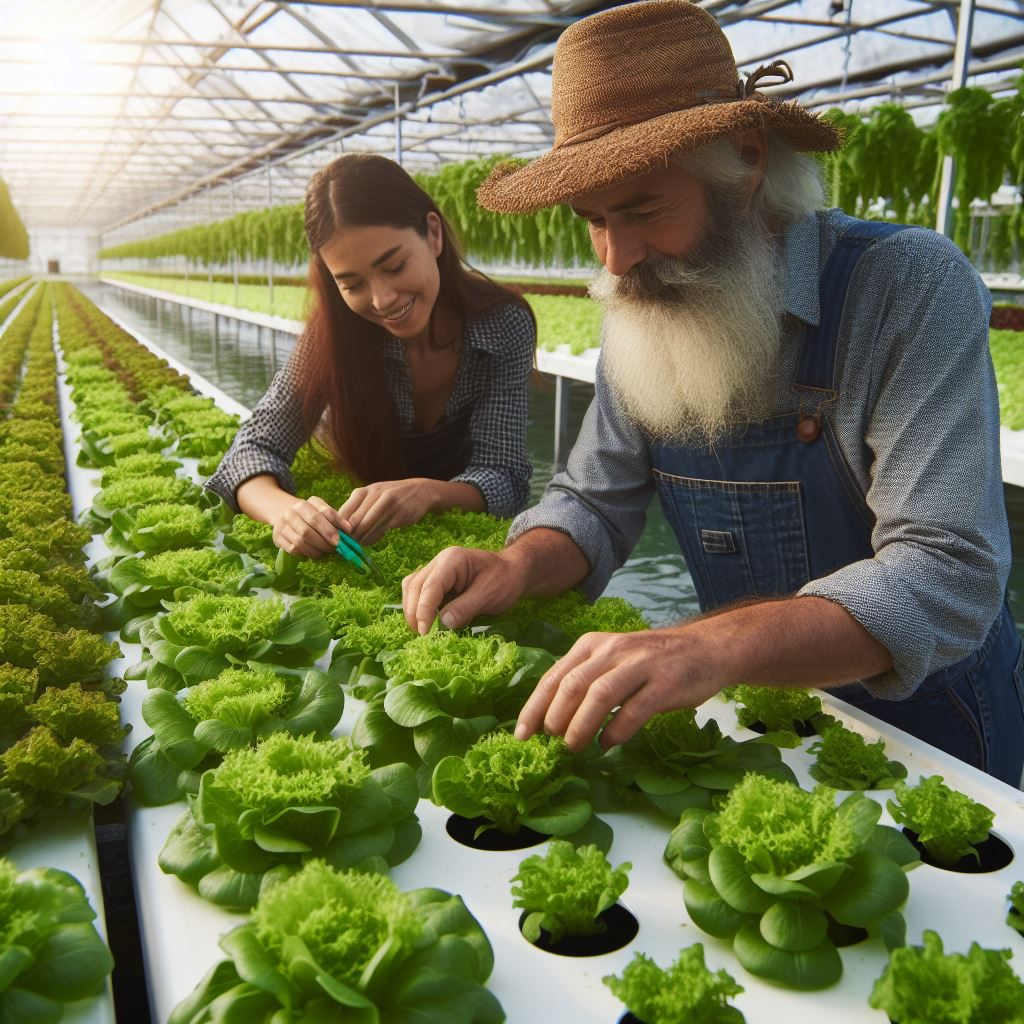Introduction
Eco-friendly farming refers to sustainable agricultural practices that minimize negative impacts on the environment and promote biodiversity.
Brief explanation of eco-friendly farming
Eco-friendly farming focuses on reducing chemical inputs, conserving water, and implementing organic practices to protect the ecosystem.
Overview of aquaponics as an eco-friendly farming method
Aquaponics is a sustainable farming technique that combines aquaculture (raising fish) with hydroponics (cultivating plants in water).
In aquaponics, fish waste provides nutrients for plants, while plants filter the water for fish.
This symbiotic relationship creates a closed-loop system that maximizes resource efficiency and minimizes waste.
Compared to traditional farming methods, aquaponics uses 90% less water, eliminates the need for chemical fertilizers, and reduces pollution.
By leveraging the natural interactions between fish, plants, and bacteria, aquaponics creates a harmonious ecosystem.
Additionally, aquaponics can be practiced in various settings, including urban areas, making it accessible and versatile.
This method also offers higher crop yields and faster growth rates, making it an efficient and productive farming technique.
Moreover, aquaponics can play a significant role in food security by providing fresh, locally grown produce all year round.
Basically, aquaponics represents an innovative and sustainable solution for eco-friendly farming, offering numerous environmental and agricultural benefits.
What is Aquaponics?
Definition of aquaponics
Aquaponics is a farming method that combines aquaculture and hydroponics to create a sustainable system.
How aquaponics works
In aquaponics, fish waste is converted into nutrients by bacteria, which are then absorbed by plants.
This mutual relationship between fish and plants allows for a continuous cycle of growth and nutrient recycling.
Benefits of using aquaponics in farming
One of the main benefits of aquaponics is that it uses 90% less water than traditional farming methods.
Transform Your Agribusiness
Unlock your farm's potential with expert advice tailored to your needs. Get actionable steps that drive real results.
Get StartedAdditionally, aquaponics eliminates the need for chemical fertilizers and pesticides, making it an eco-friendly option.
Another advantage is that it allows for year-round cultivation and can be implemented in small spaces.
Aquaponics systems can be customized to suit different types of fish and plants, offering flexibility to farmers.
By integrating aquaponics into farming practices, it is possible to produce a variety of crops and protein sources.
The symbiotic nature of aquaponics means that both fish and plants thrive in this system.
Aquaponics helps to conserve water resources, which is especially important in areas with limited water availability.
Moreover, it significantly reduces the environmental impact of farming by eliminating soil erosion and runoff pollution.
Fish are an essential component of aquaponics as they provide nutrients for the plants.
The waste produced by fish is broken down by bacteria into nitrates, which are essential for plant growth.
These nitrates are then absorbed by the plants, acting as natural fertilizers.
The plants, in turn, filter the water, keeping it clean and healthy for the fish.
This constant cycle of waste conversion and nutrient absorption creates a self-sustaining ecosystem.
Additional benefits
The plants not only benefit from the nutrients but also serve as a natural water filtration system, purifying the water for the fish.
As a result, aquaponics requires minimal input and maintenance.
The water used in aquaponics is recirculated, reducing the need for excessive water consumption.
This makes it a viable option for locations lacking access to abundant water resources.
The controlled environment of aquaponics allows for precise management of water temperature, pH, and nutrient levels.
This ensures optimal conditions for both fish and plant growth, leading to higher yields.
Aquaponics also offers increased production flexibility and scalability.
It can be implemented on a small-scale in backyard gardens or on a larger commercial scale.
By reducing the reliance on traditional farming methods, aquaponics can contribute to food security.
It provides an opportunity for farmers to grow fresh produce locally, reducing transport and storage costs.
Furthermore, aquaponics supports organic practices since it eliminates the need for synthetic fertilizers and pesticides.
As a sustainable farming method, aquaponics has the potential to revolutionize the agricultural industry.
Showcase Your Farming Business
Publish your professional farming services profile on our blog for a one-time fee of $200 and reach a dedicated audience of farmers and agribusiness owners.
Publish Your ProfileIts efficiency, resource conservation, and eco-friendly nature make it an attractive option for future food production.
By adopting aquaponics, farmers can contribute to a greener, more sustainable planet while ensuring food security for all.
Read: Indoor Eden: Hydroponic Systems for Home
Environmental Benefits of Aquaponics
Aquaponics is a sustainable farming method that combines aquaculture and hydroponics to grow fish and plants together.
It offers numerous environmental benefits that make it an attractive choice for eco-friendly farming practices.
Reduction of water usage
One of the key advantages of aquaponics is the significant reduction in water usage compared to traditional farming methods.
In aquaponics, water from the fish tank is cycled through the plant beds, allowing the plants to absorb the necessary nutrients.
The water is then recirculated back to the fish tank, creating a closed-loop system that requires minimal water replenishment.
This water conservation is crucial, especially in regions experiencing water scarcity.
Elimination of harmful runoff
Furthermore, aquaponics eliminates the problem of harmful runoff associated with conventional farming.
In traditional agriculture, excessive use of chemical fertilizers and pesticides often leads to the contamination of nearby water bodies through runoff.
However, in aquaponics, the nutrient-rich water flowing from the fish tanks acts as a natural fertilizer for the plants.
As a result, there are no harmful chemicals to be washed away, reducing the risk of polluting surrounding ecosystems.
Conservation of natural resources
Another significant environmental benefit of aquaponics is the conservation of natural resources.
Unlike traditional farming, which requires vast amounts of arable land, aquaponics can be implemented in a small space.
By utilizing vertical growing systems or stacking multiple levels of grow beds, aquaponics maximizes the productivity per square foot.
This efficient land use helps preserve natural habitats from being converted into agricultural fields, protecting biodiversity.
Reduces the need for synthetic fertilizers and herbicides
Additionally, aquaponics reduces the need for synthetic fertilizers and herbicides, further contributing to environmental preservation.
The closed-loop system relies on the interaction between fish waste, bacteria, and plant roots to supply nutrients naturally.
This organic approach eliminates the use of chemical additives, ensuring that the produce is free from harmful residues.
Moreover, it prevents the release of these chemicals into the environment, safeguarding soil health and reducing the overall carbon footprint.
Generally, aquaponics provides compelling environmental benefits that revolutionize conventional farming practices.
Through its water-saving capabilities, aquaponics tackles the issue of water scarcity, making it a sustainable choice for regions facing droughts.
Additionally, the elimination of harmful runoff and conservation of natural resources contribute to the overall ecological balance.
By minimizing the use of synthetic fertilizers and herbicides, aquaponics reinforces the importance of organic farming methods.
These environmental advantages, coupled with the high productivity and year-round crop availability, propel aquaponics as an innovative and sustainable solution for eco-friendly farming.
Read: Fish-Powered Gardens: Aquaponics Guide
Economic Benefits of Aquaponics
Aquaponics, an innovative agricultural system that combines aquaculture and hydroponics, offers several economic advantages.
By integrating fish farming and plant cultivation, it creates a mutually beneficial relationship where fish waste provides nutrients for plants, and plants filter water for fish.
This symbiotic approach leads to lower operating costs, increased productivity, profitability, and the creation of new job opportunities.
Lower Operating Costs
Aquaponics can significantly reduce operating costs compared to traditional farming methods.
One reason is the elimination of the need for chemical fertilizers, as the fish waste serves as a natural nutrient source for the plants.
By eliminating the cost of purchasing and applying synthetic fertilizers, farmers can save a considerable amount of money.
Additionally, the recirculating water system minimizes water usage, further economizing the operation.
Increased Productivity and Profitability
Aquaponics allows for higher crop yields in a shorter time span, resulting in increased productivity and profitability.
The controlled environment of the system allows plants to grow faster and produce higher-quality produce.
As a result, farmers can harvest multiple times a year, leading to more significant sales and profits.
The ability to cultivate crops throughout the year, regardless of seasonal limitations, also contributes to enhanced productivity and income.
Creation of New Job Opportunities
The implementation of aquaponics systems opens up new job opportunities within the agricultural sector.
As this sustainable farming method gains popularity, there is a rising demand for skilled workers who can design, build, and maintain aquaponics systems.
Showcase Your Farming Business
Publish your professional farming services profile on our blog for a one-time fee of $200 and reach a dedicated audience of farmers and agribusiness owners.
Publish Your ProfileThese new job roles include system engineers, technicians, farm managers, and marketing specialists.
With the continued growth of the aquaponics industry, more employment opportunities will emerge, contributing to economic development.
Essentially, aquaponics offers numerous economic benefits for farmers and communities.
Its lower operating costs, resulting from reduced need for chemical fertilizers and water conservation, allow for higher profitability.
The increased productivity achieved through faster plant growth and year-round cultivation further contributes to financial success.
Additionally, the adoption of aquaponics creates new job opportunities, fostering economic growth in the agricultural sector.
As society seeks sustainable and efficient farming methods, aquaponics displays immense potential in transforming the agricultural landscape and generating economic advantages.
Read: Hydroponics vs. Soil: What’s Best for You?
Social Benefits of Aquaponics
Aquaponics, a sustainable farming method, offers numerous social benefits that contribute to overall community well-being.
Let’s explore these advantages in more detail:
Accessibility of fresh produce
One significant social benefit of aquaponics is the increased accessibility to fresh and nutritious produce.
By implementing this farming technique, communities can cultivate a wide range of vegetables, herbs, and fruits all year round.
This accessibility plays a vital role in promoting healthier eating habits and combating food deserts.
Improvement of food security in communities
Aquaponics systems foster self-sufficiency and food security within communities.
With traditional agriculture heavily reliant on weather conditions and land availability, aquaponics provides a reliable and consistent food production method, independent of external factors.
This helps ensure a stable food supply, reducing dependency on external sources and safeguarding against potential food shortages.
Engagement in sustainable agricultural practices
By embracing aquaponics, communities actively participate in sustainable farming practices.
This environmentally friendly method promotes resource conservation by utilizing less water compared to traditional soil-based agriculture.
Additionally, it eliminates the need for chemical fertilizers and pesticides, minimizing harmful impacts on soil and water systems.
Such engagement promotes ecological awareness and fosters a sense of responsibility towards the environment.
Educational opportunities and community engagement
Aquaponics systems offer unique educational opportunities for individuals of all ages.
This innovative farming method allows communities to set up educational programs, workshops, and hands-on learning experiences centered around sustainable agriculture.
Such initiatives not only educate individuals about food systems but also raise awareness about environmental conservation and healthy eating habits, strengthening community bonds and promoting collective learning.
Job creation and economic development
Aquaponics has the potential to generate employment opportunities within communities.
As this farming technique requires specialized skills and knowledge, it creates openings for individuals interested in working with aquaponics systems, such as farm managers, aquaponics technicians, and educators.
This localized economic development fosters self-sufficiency, enhances community resilience, and helps combat unemployment.
Community empowerment and social cohesion
Implementing aquaponics systems encourages community members to actively participate in the food production process.
This hands-on involvement fosters a sense of empowerment as individuals witness the direct results of their efforts.
Collaborative activities such as planting, harvesting, and maintaining the system create opportunities for social interaction and shared experiences, strengthening social bonds and fostering a sense of belonging within the community.
Reduced environmental impact
Aquaponics significantly reduces the ecological footprint associated with conventional agriculture.
By utilizing recirculating water systems, it minimizes water usage while preventing the release of harmful agricultural runoff into natural water bodies.
Furthermore, the absence of soil-based cultivation eliminates soil erosion and degradation, preserving the integrity of land resources.
Thus, aquaponics helps communities contribute to safeguarding the environment for future generations.
In general, aquaponics offers various social benefits that positively impact communities.
From increased accessibility to fresh produce and improved food security to engagement in sustainable agricultural practices and community empowerment, this innovative farming method promotes resilience, education, and environmental stewardship.
By embracing aquaponics, communities can create a more sustainable and inclusive future, supporting both human well-being and the health of the planet.
Read: Water Works: Basics of Home Aquaponics

Challenges and Considerations in Aquaponics Farming
Aquaponics farming is an eco-friendly technique that combines aquaculture and hydroponics to create a symbiotic system.
This innovative method has gained popularity due to its numerous benefits for both the environment and food production.
However, like any other farming technique, aquaponics also comes with its own set of challenges and considerations.
Showcase Your Farming Business
Publish your professional farming services profile on our blog for a one-time fee of $200 and reach a dedicated audience of farmers and agribusiness owners.
Publish Your ProfileInitial setup costs and requirements
The initial setup costs and requirements of aquaponics farming can be quite high.
Besides constructing the system itself, other expenses include buying fish, plants, and equipment like grow beds, pumps, and filters.
Additionally, the availability of suitable land or a greenhouse is essential for setting up the system.
Knowledge and technical skills needed
Another crucial factor to consider is the knowledge and technical skills needed to operate an aquaponics farm successfully.
Farmers must have a thorough understanding of aquaculture, hydroponics, and the interplay between the two systems.
Moreover, they must be familiar with the specific requirements of the fish and plants they choose to cultivate.
Monitoring and maintaining the system
Monitoring and maintaining the aquaponics system is an ongoing task that requires consistent effort.
Regular testing of water parameters such as pH, ammonia, nitrate, and nitrite levels is vital to ensure the health of both fish and plants.
Proper nutrient balance and circulation must be maintained to avoid any imbalances or deficiencies.
Additionally, monitoring the overall system functionality, including pumps and filters, is essential for optimal performance.
How to tackle these challenges
Thorough planning and research
To tackle these challenges, thorough planning and research are crucial before embarking on aquaponics farming.
Considerations such as available resources, budget, and personal commitment should be carefully evaluated.
Seeking guidance from experienced aquaponics farmers or attending workshops and training programs can also assist aspiring farmers in acquiring the necessary knowledge and skills.
Creating a detailed checklist and budget plan
Creating a detailed checklist and budget plan can help manage initial setup costs and requirements efficiently.
It is essential to prioritize essential components and equipment based on their importance and immediate needs.
This way, farmers can gradually expand and improve their system as they gain experience and generate profits.
Acquiring the necessary knowledge and technical skills
Acquiring the necessary knowledge and technical skills for aquaponics farming can be achieved through various means.
Online resources, books, and educational videos provide valuable information on system design, fish and plant selection, and system maintenance.
Participating in hands-on training sessions or joining aquaponics communities can also foster learning and provide a supportive network for troubleshooting.
Employing automation and technology
Monitoring and maintaining the system can be simplified by employing automation and technology.
Utilizing sensors and controllers can streamline the process of monitoring water parameters and alert farmers to any deviations.
Automating tasks such as feeding fish and regulating water flow can also minimize the time and effort required for system maintenance.
In essence, aquaponics farming offers an eco-friendly and sustainable solution to food production.
While it presents challenges such as initial setup costs, the need for knowledge and technical skills, and ongoing system maintenance, these hurdles can be overcome with proper planning, research, and continuous learning.
By addressing these considerations, farmers can harness the full potential of aquaponics farming and contribute to a greener and more efficient future in agriculture.
Discover More: Small-Scale Farming: Essential Machinery
Success Stories in Aquaponics Farming
Aquaponics farming has gained significant popularity in recent years due to its sustainable and eco-friendly nature.
Here are some inspiring success stories that showcase the power of this innovative farming technique.
Examples of Successful Aquaponics Farms Around the World
- The GrowHaus in Denver, Colorado, is an urban farm that combines aquaponics and hydroponics to grow fresh produce for the local community. They have successfully transformed a food desert into a thriving source of nutritious food.
- Gotham Greens in New York City utilizes aquaponics to operate commercial rooftop greenhouses. Their farms produce high-quality, pesticide-free greens year-round, reducing the need for long-distance transportation.
- Ouroboros Farms in California is one of the largest aquaponics farms in the United States. They provide organic vegetables, herbs, and fish while minimizing water usage and eliminating the need for synthetic fertilizers.
- Urban Organics in St. Paul, Minnesota, is an indoor aquaponics farm located in a former brewery. They grow fish and vegetables sustainably, contributing to the local economy and reducing food miles.
- Spare Fruit in the United Kingdom uses aquaponics to grow fruits and vegetables in repurposed shipping containers. Their farm not only produces healthy food but also helps tackle food waste and urban blight.
Positive Impacts on Local Communities and Ecosystems
Aquaponics farming offers numerous benefits to both local communities and ecosystems:
- Increased access to fresh, nutritious food for communities with limited agricultural resources.
- Job creation and economic growth through the establishment of aquaponics farms and associated markets.
- Reduction in water usage compared to traditional farming methods, conserving this precious resource.
- Elimination of chemical fertilizers and pesticides, minimizing environmental pollution and promoting healthier ecosystems.
- Improved urban landscapes by repurposing unused spaces and transforming them into productive farms.
- Educational opportunities for schools and communities to learn about sustainable farming practices and food production.
Innovations and Advancements in Aquaponics Technology
Aquaponics technology continues to evolve, leading to improved efficiency and greater adoption of this farming technique:
- Integration of Internet of Things (IoT) technology to monitor and control aquaponics systems remotely, optimizing resource usage and productivity.
- Development of energy-efficient lighting systems, such as LED grow lights, to enhance plant growth and reduce electricity consumption.
- Use of vertical farming techniques to maximize space utilization and increase crop yields within limited urban environments.
- Exploration of new plant and fish species that are well-suited for aquaponics systems, expanding the variety of food that can be produced.
- Advancements in water filtration and recirculation systems to maintain optimal water quality and minimize waste.
In a nutshell, these success stories, positive impacts, and technological advancements depict the enormous potential of aquaponics farming.
As more farmers and communities embrace this sustainable practice, we can create a more resilient and self-sufficient food system while minimizing our ecological footprint.
Tips for Starting an Aquaponics Farm
Starting an aquaponics farm can be an exciting and environmentally friendly venture.
Aquaponics is a sustainable farming method that combines aquaculture and hydroponics, creating a symbiotic ecosystem where fish and plants thrive together.
If you are considering starting your own aquaponics farm, here are some useful tips to get you started:
Conducting thorough research and planning
- Learn about the basics of aquaponics, including the necessary equipment, fish, and plants.
- Understand the principles of maintaining water quality and managing nutrient cycles.
- Study successful aquaponics farms and gather insights from experienced farmers.
- Develop a detailed business plan, including financial projections and marketing strategies.
Seeking guidance from experienced aquaponics farmers
- Connect with local aquaponics associations or communities for valuable advice and support.
- Attend workshops, seminars, or training courses to acquire practical knowledge and skills.
- Intern or volunteer at existing aquaponics farms to gain hands-on experience.
- Establish relationships with mentors who can provide guidance throughout your journey.
Choosing the right location and equipment
- Select a site with access to clean water sources and ample sunlight.
- Consider the size and layout of the farm based on your production goals.
- Invest in high-quality aquaponics equipment, such as fish tanks, filtration systems, and grow beds.
- Ensure the facility is properly insulated and equipped with temperature control mechanisms.
Starting an aquaponics farm requires dedication, hard work, and a passion for sustainable agriculture.
By conducting thorough research, seeking guidance from experienced farmers, and choosing the right location and equipment, you can set yourself up for success in this innovative farming practice. Good luck!
Conclusion
Aquaponics farming offers numerous benefits and holds immense potential in sustainable agriculture.
The symbiotic relationship between fish and plants in a closed-loop system ensures efficient use of resources, minimal water waste, and organic produce.
By utilizing this eco-friendly farming method, we can reduce the reliance on chemical inputs and contribute to a healthier environment.
Showcase Your Farming Business
Publish your professional farming services profile on our blog for a one-time fee of $200 and reach a dedicated audience of farmers and agribusiness owners.
Publish Your ProfileAdditionally, aquaponics systems can be set up in various locations, making it accessible to individuals and communities worldwide.
As we face challenges like climate change and food scarcity, exploring and implementing eco-friendly farming methods like aquaponics becomes crucial.
Through innovation and sustainable practices, we can create a more resilient and self-sufficient food system.
So, let’s take this opportunity to dive into the world of aquaponics and explore the potential it holds for a brighter and greener future.
Together, we can make a difference in the way we farm and nurture our planet.
Start your journey towards eco-friendly farming today!




